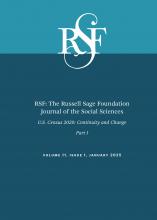Research Article
Open Access
The Deepening Gender Divide in Credentials, 2000–2020: Continuity, Change, and Implications
Claudia Buchmann, Rachel E. Dwyer, Man Yao
RSF: The Russell Sage Foundation Journal of the Social Sciences January 2025, 11 (1) 154-177; DOI: https://doi.org/10.7758/RSF.2025.11.1.08
Claudia Buchmann
aCollege of Arts and Sciences Distinguished Professor of Sociology and Faculty Affiliate of the Institution for Population Research at The Ohio State University, United States
Rachel E. Dwyer
bProfessor of sociology and faculty affiliate of the Institute for Population Research at The Ohio State University, United States
Man Yao
cAssistant professor in the Women’s and Gender Studies Program at Denison University, United States

REFERENCES
- ↵
- Anders, John,
- Mary E. Campbell,
- Craig Wesley Carpenter, and
- Luna Chandna
- ↵
- ↵
- Autor, David, and
- Melanie Wasserman
- ↵
- Blakeslee, Laura,
- Zoe Caplan,
- Julie A. Meyer,
- Megan A. Rabe, and
- Andrew W. Roberts
- ↵
- Bleemer, Zachary,
- Meta Brown,
- Donghoon Lee,
- Katherine Strair, and
- Wilbert Van der Klaauw
- ↵
- Blumenstyk, Goldie
- ↵
- Bowen, William G.,
- Matthew M. Chingos, and
- Michael McPherson
- ↵
- Brown, Meta,
- Rajashri Chakrabarti,
- Wilbert Van der Klaauw, and
- Basit Zafar
- ↵
- Buchmann, Claudia, and
- Thomas A. DiPrete
- ↵
- Buchmann, Claudia,
- Thomas A. DiPrete, and
- Anne McDaniel
- ↵
- Cameron, Margaux,
- T. Austin Lacy,
- Peter Siegel,
- Joanna Wu,
- Ashley Wilson,
- Ruby Johnson,
- Rachel Burns, and
- Jennifer Wine
- ↵
- Carpenter, Christopher S.,
- Maxine J. Lee, and
- Laura Nettuno
- ↵
- Case, Anne, and
- Angus Deaton
- ↵
- Cellini, Stephanie Riegg
- ↵
- Cellini, Stephanie Riegg, and
- Cory Koedel
- ↵
- Conwell, Jordan A., and
- Natasha Quadlin
- ↵
- Dawson, Caleb E
- ↵
- DiPrete, Thomas A., and
- Claudia Buchmann
- ↵
- DiPrete, Thomas A., and
- Claudia Buchmann
- ↵
- DiPrete, Thomas A., and
- Claudia Buchmann
- ↵
- Duffy, Mignon
- ↵
- Dwyer, Rachel E
- ↵
- Dwyer, Rachel E.,
- Randy Hodson, and
- Laura McCloud
- ↵
- Dwyer, Rachel E.,
- Laura McCloud, and
- Randy Hodson
- ↵
- Dwyer, Rachel E., and
- Erik Olin Wright
- ↵
- England, Paula,
- Andrew Levine, and
- Emma Mishel
- ↵
- Fingerman, Karen L.,
- Kyungmin Kim,
- Eden M. Davis,
- Frank F. Furstenberg Jr..,
- Kira S. Birditt, and
- Steven H. Zarit
- ↵
- ↵
- Goldrick-Rab, Sara
- ↵
- Green, Erica L
- ↵
- ↵
- Houle, Jason N., and
- Fenaba R. Addo
- ↵
- Houle, Jason N., and
- Fenaba R. Addo
- ↵
- Lachanski, Michael
- ↵
- ↵
- McMillan Cottom, Tressie
- ↵
- Mickey-Pabello, David
- ↵
- National Assessment of Educational Progress (NAEP)
- ↵
- National Center of Education Statistics (NCES)
- ↵
- National Center of Education Statistics (NCES)
- ↵
- National Center of Education Statistics (NCES)
- ↵
- National Center of Education Statistics (NCES)
- ↵
- National Center of Education Statistics (NCES)
- ↵
- National Center of Education Statistics (NCES)
- ↵
- National Center for Science and Engineering Statistics
- ↵
- Organization for Economic Cooperation and Development (OECD)
- ↵
- Park, Hyunjoon,
- Matthew Sheen, and
- Paula Clark
- ↵
- Parker, Kim
- ↵
- ↵
- Pyne, Jaymes, and
- Eric Grodsky
- ↵
- Quadlin, Natasha,
- Jordan A. Conwell, and
- Shiva Rouhani
- ↵
- Quadlin, Natasha, and
- Brian Powell
- ↵
- Radwin, David,
- Johnathan G. Conzelmann,
- Annaliza Nunnery,
- T. Austin Lacy,
- Joanna Wu,
- Stephen Lew,
- Jennifer Wine, and
- Peter Siegel
- ↵
- Seamster, Louise, and
- Raphaël Charron-Chénier
- ↵
- ↵
- Torche, Florencia
- ↵
- Valleta, Rob
- ↵
- Yavorsky, Jill E., and
- Janette S. Dill
- ↵
- Young, S. Abby,
- Ann M. Beutel, and
- Stephanie W. Burge
In this issue
The Deepening Gender Divide in Credentials, 2000–2020: Continuity, Change, and Implications
Claudia Buchmann, Rachel E. Dwyer, Man Yao
RSF: The Russell Sage Foundation Journal of the Social Sciences Jan 2025, 11 (1) 154-177; DOI: 10.7758/RSF.2025.11.1.08
Jump to section
Related Articles
- No related articles found.
Cited By...
- No citing articles found.





